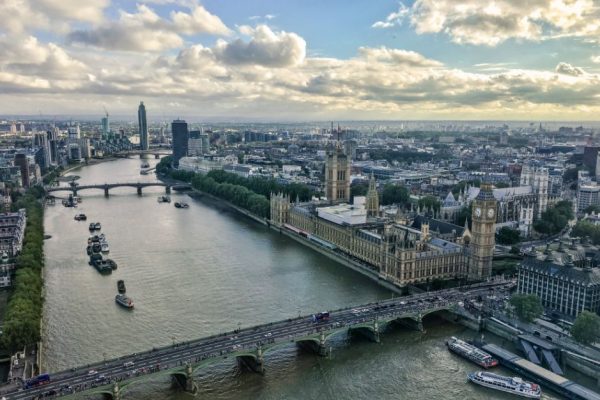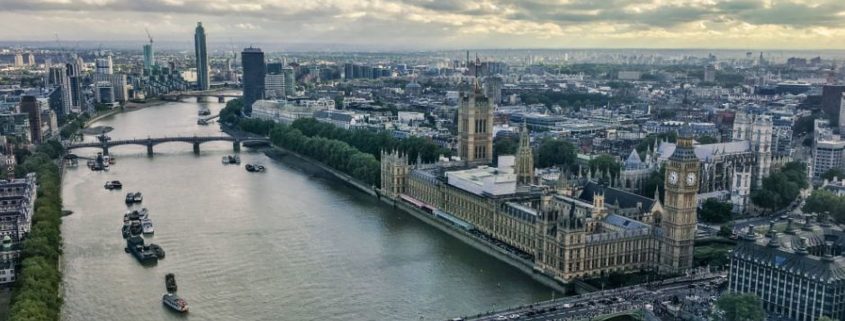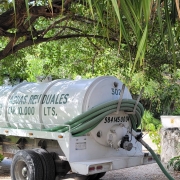Water Scarcity Looms in London’s Future
The city’s water demand is expected to exceed supply within the next decade.

London draws a majority of its water from the Thames and Lea rivers. Photo courtesy of pxhere.
The Rundown
In recent years, London has grappled with water shortages and sewage overflows as the city’s population steadily increases. Water demand is expected to exceed supply within the next decade, and severe water shortages could affect Britain’s capital by 2040.
London’s water stress is influenced by several factors. The metropolitan area receives roughly 600mm of rain each year, less than cites such as Istanbul, Turkey, and Sydney, Australia. The relatively low rainfall, coupled with the growing likelihood of hotter, drier summers, is putting pressure on the city’s water supply. At the same time, London’s population is expanding by 100,000 people each year.
London’s key water sources–the Thames and Lea rivers–are also facing pollution problems. Plastic and other debris infiltrate the waterways and clog the city’s sewer system. In addition, the rivers are sometimes deluged with wastewater when heavy rainfall overwhelms the sewage system’s treatment capacity. In order for London to avoid extreme water stress, advocates say, the city needs to cut consumption and make river preservation a priority.
“Pressure on our rivers and water supplies is only going to rise. We need to act now to ensure we have enough water for people and nature in years to come.” –Rose O’Neill, freshwater programme manager at WWF-UK, in reference to the need for careful water stewardship in London.
By The Numbers
13.4 million Possible population of London by 2050, according to the London Assembly Environment Committee. The population is currently nearing 9 million.
20 percent Amount that demand for water could outstrip London’s supply by 2040.
65 percent Proportion of London’s water that is pumped from rivers. The other 35 percent is drawn from aquifers.
£20 million ($26 million) Amount that Thames Water, London’s main water provider, was charged in March 2017 for discharging sewage into the River Thames. The leaks occurred over a 2-year period and amounted to 1.4bn litres of sewage.
70 percent Proportion of flounder in the River Thames that have bits of plastic in their guts, according to a 2015 study.
25,000 tonnes Amount of debris that Thames Water removes from its sewage system every year. Recently, fatbergs–congealed masses of cooking fat, diapers, and wipes–have been obstructing sewer pipes in London. The fatbergs increase the likelihood of raw sewage flowing into streets.
Science, Studies, and Reports
According to a 2016 study by Water UK, there is a 20 percent chance that London residents will need to queue for water at standpipes during a summer drought in the next 25 years. The researchers ran models based on climate change, population growth, and future environmental protections, and found that UK summers will likely become increasingly hot and dry. The most extreme models predicted that summer droughts could result in economic costs of up to £1.3 billion per day throughout England and Wales.
On The Radar
One recommendation for improving London’s water outlook is to utilize a “twin track” approach to water management. This method would focus on preserving the city’s current water supply while also implementing policies to lower demand. New infrastructure is needed as well, especially to help improve the city’s aging sewage system.
If London cannot incentivize residents to reduce water use, then extra storage capacity will likely be needed. Thames Water sold 25 reservoirs after becoming privatized in the late 1980s. The utility insists that the reservoirs were “service” rather than “storage” reservoirs, but the move has drawn scrutiny, especially as London’s water stress grows. In either case, the company is now faced with buying new land in order to increase water storage capacity–an expensive endeavor in modern-day London.
Resources And Further Reading
Growing London Faces Water Shortages and Overflowing Sewage (Bloomberg)
How the River Thames was brought back from the dead (BBC)
Increased drought could see Londoners queueing for water (The Guardian)
Research shows more action needed to protect against growing drought risk (Water UK)
Thames Water
Thames Water hit with record £20m fine for huge sewage leaks (The Guardian)
‘Total monster’: fatberg blocks London sewage system (The Guardian)
Kayla Ritter is a recent graduate of Michigan State University, where she studied International Relations and Teaching English to Speakers of Other Languages. She is currently based in Manton, Michigan. Kayla enjoys running, writing, and traveling. Contact Kayla Ritter










Trackbacks & Pingbacks
[…] fact that an expanding population together with pollution and waste through centralised leaks could plunge the city into crisis. With 80% of water supply drawn from river sources that have become heavily polluted and with […]
[…] Town and Flint, and those that are growing rapidly like Los Angeles, Bengaluru, Beijing and London, are on the path to ongoing drought or violent floods. As Anna Tsing notes, we all live in a […]
[…] Cape Town and Flint, and those that are growing rapidly like Los Angeles, Bengaluru, Beijing and London, are on the path to ongoing drought or violent floods. As Anna Tsing notes, we all live in a […]
Leave a Reply
Want to join the discussion?Feel free to contribute!